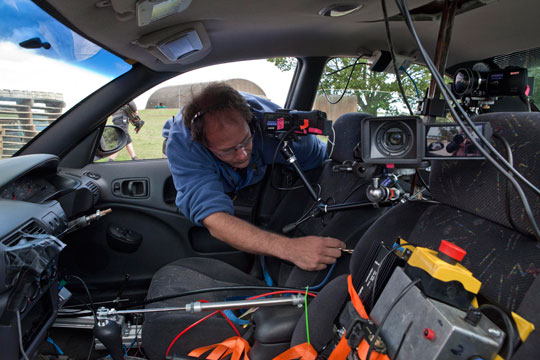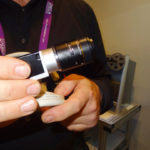
Case Study: Driving Wars
Posted on Oct 28, 2011 by Alex Fice
Driving Wars, remoted drivers controlling cars on different tracks and challenges This month the DAVE TV channel in the UK will see the appearance of Driving Wars, a clever twist on the car genre as remotely positioned drivers allowed general mayhem to happen to the vehicles. Making the remote interface work needed very low latency and the very latest receiver technology
Could you just tell us about your involvement and what you’re doing on the show?
Scott Walker – CTO of Boxx TV and Co-director: We’ve got two technologies here, the first technology is a matter of getting the four cameras that are in the car to be transmitted wirelessly into the control booth for the contestants to see. The main issue with those is they have to be very low latency because the inputs the contestants are using need to happen as real time as possible. The pictures need to come back as real time as possible so there’s no type of lag or delay in their inputs. So we using a new product we just launched at IBC this year called Zenith.
It’s a high definition H.264 system which transports over standard IP networks. We’re using 802.11N, which is the new Wi-Fi protocol that’s been designed to transport high-definition pictures, and we’re using the 5GHz license free spectrum. We’re using our own radios so have two antennas on top of the car; the advantage of that is if we lose an antenna then we are still able to continue on in most places – its pretty common the antennas get ripped off or destroyed so we have a redundancy.
 On the receive side we have another radio, (or access point), and that’s in the cherry picker and we have a tracker in that who follows the car around with fairly directional antennas. Especially on a particular route, The Road from Hell, we have to go through a lot of trees. The signal really suffers quite badly getting through trees especially when they are wet – we have a lot of rain here so we have a tracker tracking the car as it goes round the course and that helps us get the signal strength up a little bit. Then on the smaller challengers, we just have static antennas up there, which cover the area. We then decode the streams in the control booth and then bring that up on 50inch Plasmas. Depending on the size of the track and how confident we are about the signal strength and so forth we can either produce a high definition picture or a combination of HD and SD pictures depending on what we consider we can get out of the particular challenge. This can all be configured in a matter of minutes from a laptop.
On the receive side we have another radio, (or access point), and that’s in the cherry picker and we have a tracker in that who follows the car around with fairly directional antennas. Especially on a particular route, The Road from Hell, we have to go through a lot of trees. The signal really suffers quite badly getting through trees especially when they are wet – we have a lot of rain here so we have a tracker tracking the car as it goes round the course and that helps us get the signal strength up a little bit. Then on the smaller challengers, we just have static antennas up there, which cover the area. We then decode the streams in the control booth and then bring that up on 50inch Plasmas. Depending on the size of the track and how confident we are about the signal strength and so forth we can either produce a high definition picture or a combination of HD and SD pictures depending on what we consider we can get out of the particular challenge. This can all be configured in a matter of minutes from a laptop.
How much of this had been tried and tested and how much was innovated for the show?
SW: It’s always been possible but I think it comes down to the budgets. Obviously Formula One and so forth, racing cars have been getting pictures off cameras for many, many years but being able to do it at a reasonable price for four cameras is the hard part. Also in a way to protect the equipment as well, the chance of destruction of these challenges on this is very high – we go to a lot of trouble to mount all the circuitry in suspension in specially designed rubber housings and then they’re inside aluminium cases and then they’re inside suspension inside a pelican case. Touch wood we haven’t actually destroyed anything expensive yet. That’s probably been the biggest challenge, just destruction proofing everything.
 How many of your team are down here?
How many of your team are down here?
SW: We’ve got two people down here, so we have myself who runs the network and monitors as it comes in. I can see the feeds, I can see the statistics on the feeds through a web interface. I can see signal strengths and area corrections and all these kinds of interesting figures that allow me to program the system very accurately to give them the best possible picture quality they can depending on the challenge. Then we have a second operator and he’s up in the cherry picker and he tracks the cars and also helps to mount all the antennas and the encoders inside the cars. If we turn around, we have very little time to get these out and sometimes the casings, the encoders, have to be pulled out by the fire brigade, they’re wedged in that tight. It took them 40 minutes the other day to open the car up with the jaws of life and actually cut it out and get it out – it was a fairly nervous moment when you’ve got £50,000 worth of kit sitting there and you open up and its still working, it’s a good feeling!
The pictures that we see for the drivers, that’s coming straight from your feeds and what the director is seeing?
SW: The director is seeing the cameras on the field; on the tripods with the cameraman operating, that comes back from the truck. He also has a camera facing down overlooking the car and in that shot he can see all of my feeds.
How many feeds is that in total?
SW: Four feeds, so we have front, back, left, right, four feeds, four of the Sony cameras in the car provided by ProCam. They come into my encoders, I encode them in HD or SD H.264, I then put them over one single 5Ghz Wi-Fi radio which is the license free Wi-Fi spectrum, we received them with an access point which is in the cherry picker. From the access point we come down to a network switch, break out to the decoders and then out of the decoders into the plasmas outside the control room.
And that’s all pretty much instant?
SW: Pretty much, we’re probably running at about 100 milliseconds of latency which is just noticeable, you can just see it. It’s not too bad, it’s pretty good, it’s a pretty acceptable limit we’ve got there.
The cherry picker has got again two antennas on a pole, so he just tracks and follows the car around as he goes with those poles opposed to the antenna.
 So he actually physically directs the antennas to make sure you’re getting good feeds?
So he actually physically directs the antennas to make sure you’re getting good feeds?
SW: Yes exactly. And that’s the Zenith.
What’s the limit you have?
SW: We’re probably getting about 300 metres through some pretty thick foliage, which is pretty good. In an open space, like when we do the ‘jump’ or the ‘movie medley’ we can go a kilometre with absolutely no problem. For open space it goes on forever. We haven’t actually tried to go over a kilometre but we can easily do a kilometre with this particular technology, so it does go along way but with trees, especially when its wet, effects the signal quite dramatically. The second technology we’ve got here is a technology we call Cerulean.
It’s basically a system that we call ‘wireless fibre’ and it works on the 60GHz spectrum which is extremely high frequency, it’s a licence exempt frequency around the world, and it allows you to transport two channels of full HD uncompressed (mathematically lossless) camera feeds over a range of about 500m. The good thing about that is that there’s absolutely no compression, there’s absolutely no delay, it is exactly the same as using a piece of fibre. In this particular job of course its just used for monitoring, in an OB scenario or a high end broadcast, high end production, it is exactly the same quality as a fibre optic cable but without the hassles and the problems of possibly having to run that. So were using it here just for a monitoring platform, but it is a brilliant technology to get rid of a piece of fibre optic cable.
How did you get involved in this project?
 SW: John Brennan at ProCam recommended me. John knew me through a trade show and then Dom, the producer, came and saw me, and showed me the treatment, and I just went ‘I’ve got to do it’ it sounded like so much fun, smashing cars up…
SW: John Brennan at ProCam recommended me. John knew me through a trade show and then Dom, the producer, came and saw me, and showed me the treatment, and I just went ‘I’ve got to do it’ it sounded like so much fun, smashing cars up…
Is this the first project you’ve worked with ProCam Television?
SW: It is actually and its been fantastic, the guys here are just so fast, so professional, so quick, just such nice guys to work with. We got on really well. The crossover between them and us has been really good, they do a bit of stuff for us, we do a bit of stuff for them, there are no egos involved, it’s been really good.
Is it a very specific tech team involved?
SW: Everyone here is an expert in their field, we’ve got ProCam you’ve got the guys doing the remote control, you’ve got us doing the microwave, but the whole idea of this program is virtually untested, and it was really a case of ‘make it up as you go along’. The first few days it was probably one of the most hectic jobs I’ve ever done. Just no one knows what’s going to happen, no-one knows how it’s going to work, it was a bit of skill and probably a lot of luck to get the show up and to get it working the way it was.













